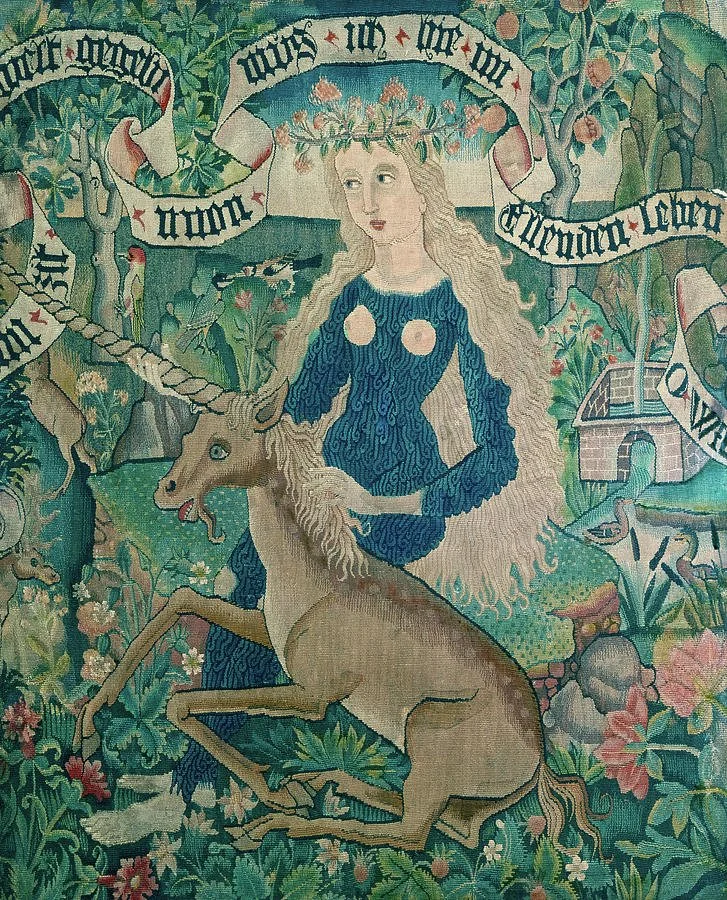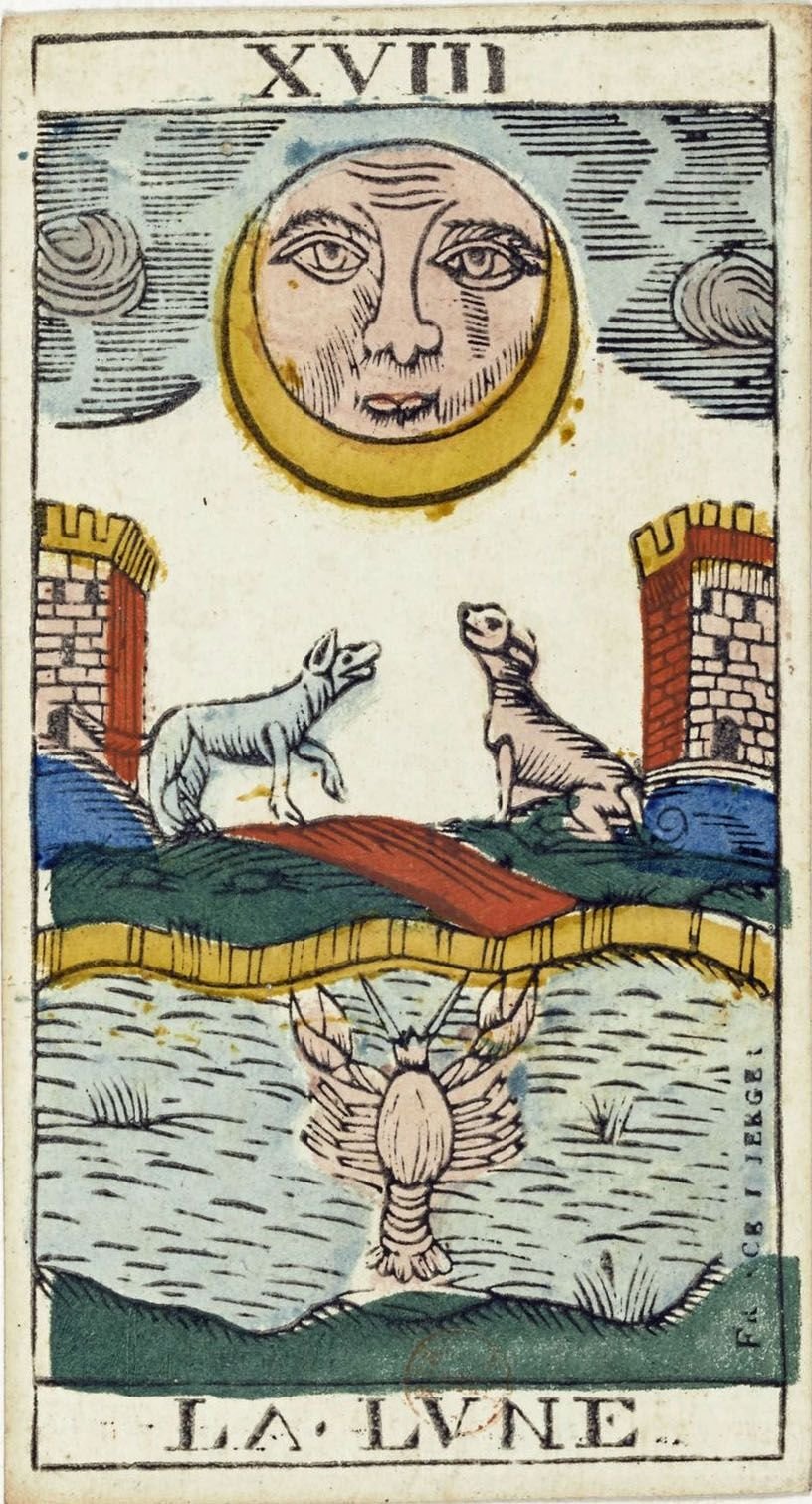PAST CLASS Prophetic Bestiary: Animal Power, Symbolism and Mythical Teaching In the Tarot, with Laetitia Barbier, Beginning December 7
3 Weeks Online Course taught via Zoom by Morbid Anatomy Programing Director Laetitia Barbier
Wednesdays December 7, 14, and 21
7 pm ET (NYC Time)
$100 (Patreon Members $5/mo and above) / $125 (Regular Admission)
PLEASE NOTE: All classes will also be recorded and archived for students who cannot make that time
Please note: Zoom invites are sent five days before the first class meeting. If you do not receive it, please email us at info.morbidanatomy@gmail.com.
Pale horses and crayfish. Foxes, ibis and cats. Tarot, from its earlier hours in 15th Century Italy, shapes itself as a symbolic zoo, the fauna serving as metaphorical counterpoint concealing latent meanings, a subtext read in parallel to the allegorical content of each card.
From Ancient Egypt to Medieval heraldry, animals assume different identities, from divine messengers, mischievous helpers or moral example, a matrix of interpretation evolving through time, shape-shifting from one civilization to the next. The subjective, poetic observation of nature served as the substrate of myth, allowing to reconcile, reorganize the visible and the invisible manifestation of the natural world.
Together, and for the first two classes, we’ll travel through time, using Tarot as a kind of magic carpet, guiding us through a cross-cultural journey through the kingdom of beasts, chimeras and theriomorphic gods. From Ovid’s Metamorphosis to European folktales, we’ll look at animality in a variety of card divination systems as a repository of symbolic and often magical attributes. Tarot’s iconography can be viewed as a spectacular cabinet of curiosity, arranging esoteric teaching drawn from the natural world using the arcanas as a template.
In the third class, we’ll try to connect in a more animist approach to the cards, using fantasized and real animal behavior to reshape our understanding of the cards in creative ways. Through practical exercises, meditation and hands-on experimentation, we’ll imagine new configurations to rewild our Tarot eye and awaken our instinct as readers.
Class 1 - Animals as Seers
Animals in Historical Tarot Decks
Divination and the Natural World
Animal Gods and Their Worship.
Class 2: Animals as Teachers
Allegorical and their Symbolic Meanings.
Zoological myth and their teaching.
Unnatural History and Fantasized Fauna in the Tarot.
Class 3: Practice Class
Reading like a beast: an instinctive way of reading cards
Rewilding the basics of Tarot
Animal Tarot - experimenting with zoo-centric decks.
French born Laetitia Barbier is an independent scholar, as well as professional tarot reader and teacher. She earned a Bachelor Degree in Art History from La Sorbonne University Paris in 2009. Laetitia has worked with Morbid Anatomy since 2012 as a programming director, head librarian and occasional curator. She is the author of Tarot and Divination Cards: A Visual Archive. She lives in Brooklyn, New York.
Images:
10 of Heart from a French divination deck, early 19th Century
"Verkehrte Welt” German Tarot, 1840s
Wild woman with unicorn, French Tapestry, 1500
Moon card, Tarot de Besançon, 19th Century
World card, Jean Noblet Tarot, 1659
Fish Card, Petit Lenormand, Germany, 1875
Queen of Wands, Rider Waite Smith, Contemporary Edition, 20th Century
3 Weeks Online Course taught via Zoom by Morbid Anatomy Programing Director Laetitia Barbier
Wednesdays December 7, 14, and 21
7 pm ET (NYC Time)
$100 (Patreon Members $5/mo and above) / $125 (Regular Admission)
PLEASE NOTE: All classes will also be recorded and archived for students who cannot make that time
Please note: Zoom invites are sent five days before the first class meeting. If you do not receive it, please email us at info.morbidanatomy@gmail.com.
Pale horses and crayfish. Foxes, ibis and cats. Tarot, from its earlier hours in 15th Century Italy, shapes itself as a symbolic zoo, the fauna serving as metaphorical counterpoint concealing latent meanings, a subtext read in parallel to the allegorical content of each card.
From Ancient Egypt to Medieval heraldry, animals assume different identities, from divine messengers, mischievous helpers or moral example, a matrix of interpretation evolving through time, shape-shifting from one civilization to the next. The subjective, poetic observation of nature served as the substrate of myth, allowing to reconcile, reorganize the visible and the invisible manifestation of the natural world.
Together, and for the first two classes, we’ll travel through time, using Tarot as a kind of magic carpet, guiding us through a cross-cultural journey through the kingdom of beasts, chimeras and theriomorphic gods. From Ovid’s Metamorphosis to European folktales, we’ll look at animality in a variety of card divination systems as a repository of symbolic and often magical attributes. Tarot’s iconography can be viewed as a spectacular cabinet of curiosity, arranging esoteric teaching drawn from the natural world using the arcanas as a template.
In the third class, we’ll try to connect in a more animist approach to the cards, using fantasized and real animal behavior to reshape our understanding of the cards in creative ways. Through practical exercises, meditation and hands-on experimentation, we’ll imagine new configurations to rewild our Tarot eye and awaken our instinct as readers.
Class 1 - Animals as Seers
Animals in Historical Tarot Decks
Divination and the Natural World
Animal Gods and Their Worship.
Class 2: Animals as Teachers
Allegorical and their Symbolic Meanings.
Zoological myth and their teaching.
Unnatural History and Fantasized Fauna in the Tarot.
Class 3: Practice Class
Reading like a beast: an instinctive way of reading cards
Rewilding the basics of Tarot
Animal Tarot - experimenting with zoo-centric decks.
French born Laetitia Barbier is an independent scholar, as well as professional tarot reader and teacher. She earned a Bachelor Degree in Art History from La Sorbonne University Paris in 2009. Laetitia has worked with Morbid Anatomy since 2012 as a programming director, head librarian and occasional curator. She is the author of Tarot and Divination Cards: A Visual Archive. She lives in Brooklyn, New York.
Images:
10 of Heart from a French divination deck, early 19th Century
"Verkehrte Welt” German Tarot, 1840s
Wild woman with unicorn, French Tapestry, 1500
Moon card, Tarot de Besançon, 19th Century
World card, Jean Noblet Tarot, 1659
Fish Card, Petit Lenormand, Germany, 1875
Queen of Wands, Rider Waite Smith, Contemporary Edition, 20th Century
3 Weeks Online Course taught via Zoom by Morbid Anatomy Programing Director Laetitia Barbier
Wednesdays December 7, 14, and 21
7 pm ET (NYC Time)
$100 (Patreon Members $5/mo and above) / $125 (Regular Admission)
PLEASE NOTE: All classes will also be recorded and archived for students who cannot make that time
Please note: Zoom invites are sent five days before the first class meeting. If you do not receive it, please email us at info.morbidanatomy@gmail.com.
Pale horses and crayfish. Foxes, ibis and cats. Tarot, from its earlier hours in 15th Century Italy, shapes itself as a symbolic zoo, the fauna serving as metaphorical counterpoint concealing latent meanings, a subtext read in parallel to the allegorical content of each card.
From Ancient Egypt to Medieval heraldry, animals assume different identities, from divine messengers, mischievous helpers or moral example, a matrix of interpretation evolving through time, shape-shifting from one civilization to the next. The subjective, poetic observation of nature served as the substrate of myth, allowing to reconcile, reorganize the visible and the invisible manifestation of the natural world.
Together, and for the first two classes, we’ll travel through time, using Tarot as a kind of magic carpet, guiding us through a cross-cultural journey through the kingdom of beasts, chimeras and theriomorphic gods. From Ovid’s Metamorphosis to European folktales, we’ll look at animality in a variety of card divination systems as a repository of symbolic and often magical attributes. Tarot’s iconography can be viewed as a spectacular cabinet of curiosity, arranging esoteric teaching drawn from the natural world using the arcanas as a template.
In the third class, we’ll try to connect in a more animist approach to the cards, using fantasized and real animal behavior to reshape our understanding of the cards in creative ways. Through practical exercises, meditation and hands-on experimentation, we’ll imagine new configurations to rewild our Tarot eye and awaken our instinct as readers.
Class 1 - Animals as Seers
Animals in Historical Tarot Decks
Divination and the Natural World
Animal Gods and Their Worship.
Class 2: Animals as Teachers
Allegorical and their Symbolic Meanings.
Zoological myth and their teaching.
Unnatural History and Fantasized Fauna in the Tarot.
Class 3: Practice Class
Reading like a beast: an instinctive way of reading cards
Rewilding the basics of Tarot
Animal Tarot - experimenting with zoo-centric decks.
French born Laetitia Barbier is an independent scholar, as well as professional tarot reader and teacher. She earned a Bachelor Degree in Art History from La Sorbonne University Paris in 2009. Laetitia has worked with Morbid Anatomy since 2012 as a programming director, head librarian and occasional curator. She is the author of Tarot and Divination Cards: A Visual Archive. She lives in Brooklyn, New York.
Images:
10 of Heart from a French divination deck, early 19th Century
"Verkehrte Welt” German Tarot, 1840s
Wild woman with unicorn, French Tapestry, 1500
Moon card, Tarot de Besançon, 19th Century
World card, Jean Noblet Tarot, 1659
Fish Card, Petit Lenormand, Germany, 1875
Queen of Wands, Rider Waite Smith, Contemporary Edition, 20th Century


![[Jeu_de_tarot_allemand_de_[...]_btv1b105371802.JPEG](https://images.squarespace-cdn.com/content/v1/5bdf8c4036099b2eb8d2ae92/1657290258659-ANALE813S8S6V5C8BJQH/%5BJeu_de_tarot_allemand_de_%5B...%5D_btv1b105371802.JPEG)


![[Jeu_de_tarot_à_enseignes_[...]_btv1b105109641.jpg](https://images.squarespace-cdn.com/content/v1/5bdf8c4036099b2eb8d2ae92/1657290833393-4WU6ZI1BYV700304T2KM/%5BJeu_de_tarot_a%CC%80_enseignes_%5B...%5D_btv1b105109641.jpg)


